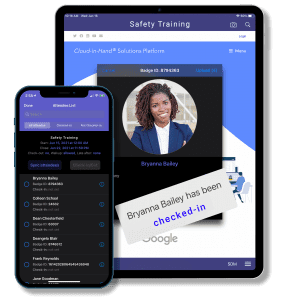Emergency Evacuation Mustering Saves Lives
Emergency evacuation mustering is vital when it comes to ensuring the safety of your employees and visitors. It’s all about organizing and executing a swift and efficient evacuation process that leaves no room for panic or confusion. Utilizing experience from boots on the ground EHS Pros, we’ll share the wisdom we’ve gained ensuring your Emergency Management knowledge goes to a new level. Be the safety superhero your colleagues respect!
Understanding Emergency Evacuation Mustering
Evacuation plans involve emergency mustering to safely gather and account for all personnel during an emergency. The primary goal is to ensure Employees, Contractors, and Visitors are all accounted for at designated assembly areas. Environmental Health & Safety (EHS) Supervisors coordinate the evacuation, provide clear instructions, and guide individuals to safety. The speed at which you initiate the evacuation and communicate instructions can have a significant impact on the overall outcome. Every second matters, which is why it’s vital to practice efficient communication strategies and response protocols.
#1: Prepare Emergency Evacuation Mustering Plan
 A well-thought-out emergency plan lays the foundation for a successful evacuation process, ensuring everyone knows what to do when the alarm sounds. To begin, assess your premises and identify the most efficient evacuation routes, considering factors like exit locations, stairwells, and emergency exits. Remove any potential obstacles and guarantee that evacuation routes are clearly marked with visible signage. Additionally, establish accessible assembly areas and provide clear guidelines for personnel. Conduct regular drills and training sessions to ensure everyone is familiar with the plan. Simulate realistic scenarios for effective preparedness.
A well-thought-out emergency plan lays the foundation for a successful evacuation process, ensuring everyone knows what to do when the alarm sounds. To begin, assess your premises and identify the most efficient evacuation routes, considering factors like exit locations, stairwells, and emergency exits. Remove any potential obstacles and guarantee that evacuation routes are clearly marked with visible signage. Additionally, establish accessible assembly areas and provide clear guidelines for personnel. Conduct regular drills and training sessions to ensure everyone is familiar with the plan. Simulate realistic scenarios for effective preparedness.
#2: Utilize Technology for Real-Time Monitoring
In today’s digital age, technology presents incredible opportunities to elevate the effectiveness of emergency evacuation mustering. Real-time monitoring systems are your trusted ally for personnel safety and accountability. Invest in seamless tracking solutions like Cloud-In-Hand® Time & Attendance, which leverages RFID (Radio Frequency Identification) and built-in redundancy for precise location monitoring. Gain a comprehensive view of personnel movements in real-time to ensure a smooth and efficient evacuation.
Explore the use of mobile devices and smart sensors that can provide vital information during an emergency. Track vital signs, detect the presence of hazardous substances, or even notify responders of personnel in distress. Equipping your team with these devices can maximize safety and streamline the muster process.
#3: Effective Communication Strategies
 Communication is key during emergency evacuations, and technology can help you streamline the process. Utilize communication tools like mobile apps or two-way radios to provide instant updates and alerts. These tools ensure that everyone receives crucial information promptly and can make informed decisions during the evacuation.
Communication is key during emergency evacuations, and technology can help you streamline the process. Utilize communication tools like mobile apps or two-way radios to provide instant updates and alerts. These tools ensure that everyone receives crucial information promptly and can make informed decisions during the evacuation.
In high-stress situations, verbal communication alone may not be sufficient. Incorporate visual cues, such as clear signage and flashing lights, to convey urgency and guide individuals toward evacuation routes. Provide comprehensive training to safety supervisors on effective communication techniques, such as remaining calm, speaking clearly and assertively, and actively listening to questions from personnel.
#4: Optimize Emergency Evacuation Mustering Routes
Assess and refine evacuation paths for a smoother process. Identify potential bottlenecks, such as narrow corridors and congested areas. Eliminate any obstacles that may impede the flow of personnel during an evacuation. For instance, you can rearrange furniture to create wider pathways, keep corridors clear of obstructions, and address any structural limitations that could hinder a swift evacuation. Don’t limit yourself to a single evacuation route. Explore alternative paths that can be used during different scenarios or if primary routes become compromised. Identify secondary exits, stairwells, or even windows that can serve as safe alternatives. By having multiple evacuation options, you can evenly distribute the flow of personnel, reduce congestion, and ensure a faster and safer evacuation for everyone involved.
#5: Empowering Employees as Safety Ambassadors
Safety should be at the core of your organization’s values. Promote safety culture by emphasizing preparedness, encouraging open communication about safety concerns, and recognizing individuals who prioritize safety. Encourage employees to be proactive in identifying potential hazards by making reporting hazards and suggesting improvements easy with clear mechanisms to voice their concerns. Regularly review and address reported concerns, ensuring employees feel heard and valued.
#6: Continuous Improvement and Evaluation
 Utilize data analysis to gain insights into your emergency evacuation mustering processes. Analyze evacuation metrics like evacuation times, response times, and personnel accountability rates. Identify trends and areas for improvement. Implement technology-driven solutions, such as evacuation management software, to streamline data collection and analysis. Stay current with industry best practices and emerging technologies through conferences, training programs, and networking. Incorporate these practices to demonstrate commitment to continuous improvement and elevate safety standards.
Utilize data analysis to gain insights into your emergency evacuation mustering processes. Analyze evacuation metrics like evacuation times, response times, and personnel accountability rates. Identify trends and areas for improvement. Implement technology-driven solutions, such as evacuation management software, to streamline data collection and analysis. Stay current with industry best practices and emerging technologies through conferences, training programs, and networking. Incorporate these practices to demonstrate commitment to continuous improvement and elevate safety standards.
Conclusion
People and Processes are what make an Organization great, Safety is no different! Cloud-in-Hand® emergency evacuation mustering improves your current process and engages your people to ensure safety is paramount. Implement these strategies to become a master of preparedness, communication, optimization, and continuous improvement. Every second counts, so stay vigilant, prepared, and prioritize the safety of those under your care. Your unwavering dedication has a profound impact on lives, and we commend you. Embrace these hacks, refine your techniques, and be a beacon of safety in chaotic times.


